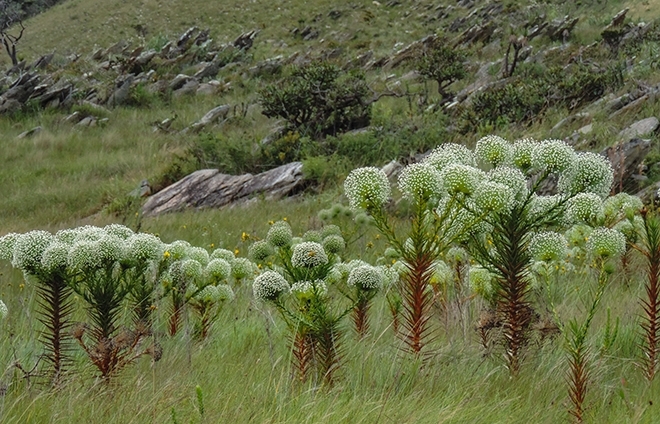

Special issue of scientific journal compiles current knowledge about the plant life of this endangered and poorly understood ecosystem stretching from Southeast to Northeast Brazil (photos: Thiago Sanna Freire Silva, Maria Gabriela de Camargo, Patrícia Morellato)
Special issue of scientific journal compiles current knowledge about the plant life of this endangered and poorly understood ecosystem stretching from Southeast to Northeast Brazil.
Special issue of scientific journal compiles current knowledge about the plant life of this endangered and poorly understood ecosystem stretching from Southeast to Northeast Brazil.

Special issue of scientific journal compiles current knowledge about the plant life of this endangered and poorly understood ecosystem stretching from Southeast to Northeast Brazil (photos: Thiago Sanna Freire Silva, Maria Gabriela de Camargo, Patrícia Morellato)
By Elton Alisson | Agência FAPESP – In Serra do Espinhaço, a Brazilian mountain range that extends from Minas Gerais State in the Southeast to Bahia State in the Northeast, it is possible to observe an ancient type of vegetation called campo rupestre, literally “rocky field” but described by experts as montane savanna. The habitat contains a high diversity of plant species, most of which are endemic (found solely in the area).
This ecosystem is endangered and has yet to be thoroughly researched, scientists warn, although it drew the attention of nineteenth- and twentieth-century naturalists who visited Brazil, such as Danish botanist Eugen Warming (1841-1924).
To compile all current knowledge on plant life in the campo rupestre ecoregion, Patrícia Morellato, a professor in São Paulo State University’s Rio Claro Bioscience Institute (IBRC-UNESP), in partnership with Fernando Augusto de Oliveira e Silveira, a professor in the Federal University of Minas Gerais’s Biological Science Institute (ICB-UFMG), organized a special issue of the journal Flora on the subject.
Some of the studies published in the special issue resulted from a project conducted by Morellato under the aegis of an agreement between mining company Vale and FAPESP in partnership with its counterparts in Minas Gerais (FAPEMIG) and Pará (FAPESPA), and an ongoing project led by Morellato, with funding from FAPESP in partnership with Microsoft. Both projects concern Serra do Cipó, a geological formation located in Minas Gerais in the southern portion of the Espinhaço geological province.
“The Espinhaço mountain range, especially the Serra do Cipó portion, is a diversity hotspot, with more endemic plant species than any Brazilian ecoregion,” Morellato told Agência FAPESP.
A possible explanation for the remarkable diversity and endemism of plant species in the campo rupestre of Serra do Espinhaço relates to the geological history of this 1,000 km-long chain of peaks and valleys formed more than 1 billion years ago.
The chain’s geological evolution entailed diversification into a mosaic of landscapes featuring rocky outcrops, stony and sandy wet grasslands, and forest islands. This diversified ecoregion is surrounded by three large biomes: Cerrado, Atlantic Rainforest, and Caatinga.
“All these traits, in addition to the climate characterized by a cold dry season alternating with a warm wet season, allowed this highly diverse vegetation to evolve in Serra do Espinhaço,” Morellato explained.
The researchers reiterate a proposal they first presented in an article published in 2016 in the journal Plant and Soil, calling for the classification of campo rupestre as a “very old, climatically buffered, infertile landscape” (OCBIL).
Application of OCBIL theory to campo rupestre, they argue, would permit the testing of hypotheses regarding the evolution of this kind of vegetation, as well as recognition by the scientific community that the Brazilian ecosystem is similar to the fynbos of southwestern South Africa and the kwongkan of Western Australia.
“There are only a few regions on Earth that are OCBIL-type ancient zones with infertile soil and that simultaneously show high species diversity,” Morellato said.
Cameras and drones
Classifying campo rupestre as a type of OCBIL would also help promote scientific collaboration among researchers on the continents that have such ecozones, as well as supporting the conservation and sustainable use of the Brazilian region and other ancient landscapes, the researchers contend.
Species endemic to campo rupestre, such as Comanthera elegantula (sempre-viva or “everlasting”) and Vellozia gigantea (canela-de-ema-gigante), are threatened by uncontrolled burning and by overharvesting for use as ornamental plants. In addition, a large proportion of this Brazilian ecozone has been destroyed by mining before it could be studied.
“Because the vegetation in campo rupestre sits on top of rocky outcrops that frequently contain iron and other minerals, much of it has been destroyed by mining. Today, this economic activity is the greatest threat to the diversity of this ecosystem about which we know so little,” Morellato said.
Via the project funded by FAPESP and Vale (with FAPEMIG and FAPESPA), Morellato studied the relationships between the plant species endemic to Serra do Cipó and the environment (phenology), as well as their pollination, with the aim of planning restoration actions.
The results of the studies were published in a chapter of the book Ecology and Conservation of Mountaintop Grasslands in Brazil and in the journals Ecology and PLOS ONE.
Via the project funded by FAPESP and Microsoft, the researchers have used technologies such as cameras and drones to monitor the vegetation in Serra do Cipó and study seasonal changes at different altitudes.
“The idea is to reach a better understanding of the growth season for vegetation in Serra do Cipó and what determines its beginning and end, so that we can identify the triggers for changes in the landscape,” Morellato said.
The special issue of Flora entitled “Plant life on campo rupestre, a megadiverse Neotropical old-growth grassland” can be read at sciencedirect.com/journal/flora/vol/238/suppl/C.
Republish
The Agency FAPESP licenses news via Creative Commons (CC-BY-NC-ND) so that they can be republished free of charge and in a simple way by other digital or printed vehicles. Agência FAPESP must be credited as the source of the content being republished and the name of the reporter (if any) must be attributed. Using the HMTL button below allows compliance with these rules, detailed in Digital Republishing Policy FAPESP.





